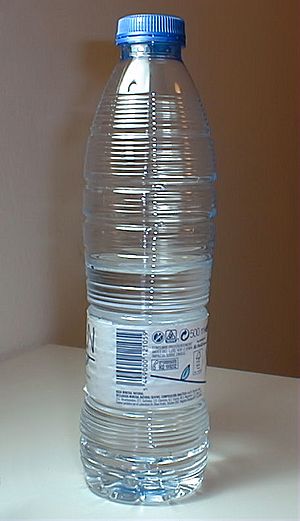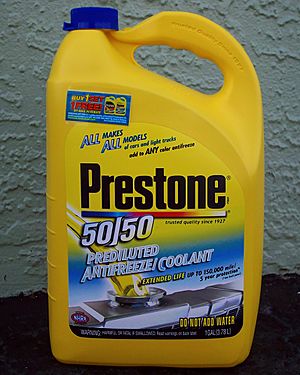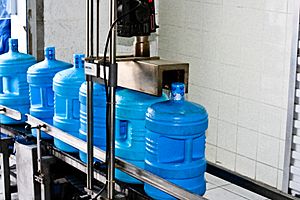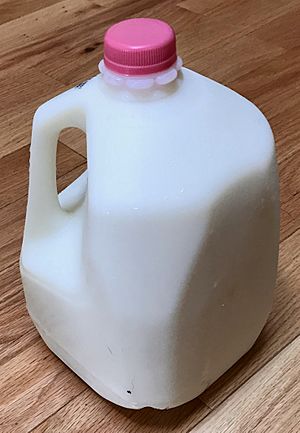Plastic bottle facts for kids
A plastic bottle is a bottle made from plastic. These bottles are often used to hold liquids like water, soft drinks, milk, shampoo, and even motor oil. They come in many sizes, from tiny ones to very large containers called carboys. Many plastic bottles are shaped to be easy to hold or have handles built right into them.
Plastic was first invented in the 1800s. It was used to replace natural materials like ivory and rubber. Plastic bottles started being used for businesses in 1947. At first, they were quite expensive. But by the early 1950s, a new type of plastic called high-density polyethylene became available. This made plastic bottles much cheaper to make.
Plastic bottles quickly became popular with companies and customers. They were lighter, cheaper, and easier to move around than glass bottles. The biggest benefit of plastic bottles is that they don't break as easily as glass. This is helpful during both manufacturing and shipping. Today, most of the food industry uses plastic bottles instead of glass, except for wine and beer.
Contents
How Plastic Bottles Are Made

The type of plastic used to make bottles depends on what the bottle will be used for. Different plastics have different strengths and weaknesses.
Types of Plastic Used
Here are some common types of plastic used for bottles:
- High-density polyethylene (HDPE): This is the most common plastic for bottles. It's affordable, strong, and keeps moisture out well. HDPE is good for many products, including acids. It's often used for milk jugs and detergent bottles.
- Low-density polyethylene (LDPE): LDPE is similar to HDPE but is softer and more flexible. It's often used for bottles that need to be squeezed, like those for honey or glue.
- Polyethylene terephthalate (PET or PETE): This plastic is widely used for fizzy drinks and water bottles. PET is very strong and good at keeping out alcohol and oils. It's not good for very hot liquids.
- Polypropylene (PP): PP is a stiff plastic often used for jars and bottle caps. It can handle high temperatures, so it's used for products that are filled hot. It's also very resistant to chemicals.
- Polyvinyl chloride (PVC): PVC is naturally clear and strong. It's good at blocking oils and gases. However, it can get damaged by some chemicals and high temperatures. In recent years, there have been some concerns about its safety.
- Post-consumer resin (PCR): This is a mix of recycled plastic, mostly from milk and water bottles, and new plastic. PCR is cheaper and helps the environment by using recycled materials. However, it cannot be used for food or medicine bottles directly.
Other Materials Used
- Bioplastics: These plastics are made from natural materials like starch or vegetable oil, not from oil. The main idea behind bioplastics is that they can break down more easily in the environment.
- Bisphenol A (BPA): BPA is a chemical used to make some plastics, like those found in reusable drink containers and food storage containers. There have been concerns about BPA possibly getting into food or drinks from these containers.
Concerns About Plastic Bottles

There are ongoing concerns about how plastics are used for food packaging and their impact on the environment. One big worry is plastic pollution, which harms our planet. There are also concerns about whether chemicals from plastics can get into our food or drinks.
Some experts suggest that tiny amounts of chemicals from plastics might affect human health. For example, some studies have looked into whether these chemicals could be linked to problems like infertility.
In the United States, the Food and Drug Administration (FDA) checks plastic water bottles and the factories that make them. In 2010, the FDA said it had concerns about possible health risks from plastics.
Recent research has found tiny pieces of plastic, called microplastics, in bottled water. These microplastics come from the plastic bottles themselves. Scientists are studying how these tiny particles might affect our bodies. Most microplastics are thought to pass through the body, but very small ones might be able to enter the bloodstream and organs.
Labels on Plastic Bottles
Plastic bottles usually have a special code at the bottom called the resin identification code. This code is a number inside a triangle of arrows. It tells you what type of plastic the bottle is made from. This helps with recycling.
Product labels are usually stuck on with glue or shrunk to fit the bottle. Sometimes, the label is even built into the bottle during the molding process.
Special Types of Plastic Bottles
Collapsible Bottles
An accordion bottle or collapsible bottle is a plastic bottle that can be squeezed to remove air from inside. This is useful for chemicals that spoil when exposed to air. It also saves space when the bottle is empty or as its contents are used up. Hikers often use collapsible water bottles.
Carbonated Drink Bottles
Bottles used for fizzy drinks like carbonated water and soft drinks often have a bumpy or uneven bottom. This design helps make the bottle more stable and stronger, especially when it's holding pressure from the carbonation. This technology was invented and patented by Domas Adomaitis in 1971.
See also
 In Spanish: Botella de plástico para niños
In Spanish: Botella de plástico para niños






